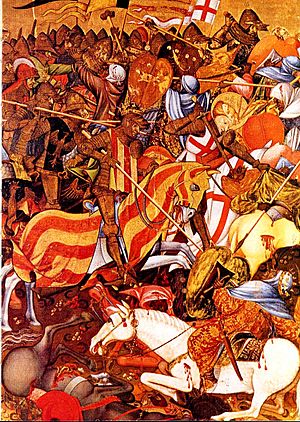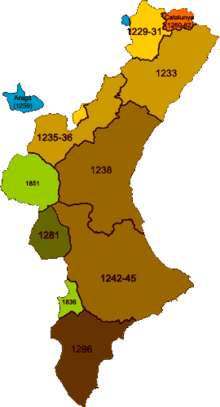Battle of the Puig facts for kids
Quick facts for kids Battle of El Puig de Santa Maria |
|||||||
|---|---|---|---|---|---|---|---|
| Part of the Reconquista (Aragonese conquest of Valencia) | |||||||
 The Battle of the Puig de Santa Maria by Andrés Marzal de Sas |
|||||||
|
|||||||
| Belligerents | |||||||
| Crown of Aragon | Taifa of Valencia | ||||||
| Commanders and leaders | |||||||
| Bernat Guillem I d'Entença | Zayyan ibn Mardanish | ||||||
| Strength | |||||||
| 50 knights and 1,000 foot soldiers | 600 cavalry unknown soldiers |
||||||
The Battle of the Puig in 1237 was a very important fight during the Reconquista. This was a long period when Christian kingdoms in Spain tried to take back land from Muslim rulers. This battle was a key part of the Aragonese conquest of Valencia.
The battle happened in August 1237. It was fought between the forces of the Crown of Aragon, led by Bernat Guillem I d'Entença, and the forces of the Taifa of Valencia, led by Zayyan ibn Mardanish. The Aragonese won a big victory, which helped them conquer the city of Valencia.
Contents
Why the Battle Happened
The Muslim Kingdoms in Spain
Long ago, much of Spain was ruled by Muslim leaders. These lands were part of a large empire called the Almohad Caliphate. But after a big defeat at the Battle of Las Navas de Tolosa, this empire started to break apart. It split into many smaller kingdoms called taifas. Think of them like small independent states.
In the area of Valencia, the local Muslim governors, like Zayd Abu Abd Allah Muhammad and Zayd Abu Zayd, had a lot of power. They could make their own decisions.
James I's First Attempts
In 1224, James I of Aragon, the Christian king, wanted to conquer the Muslim-controlled city of Valencia (which was called Balansiya back then). He started by moving his army into the area.
Zayd Abu Zayd quickly asked James I for a peace deal. James I agreed, in exchange for a share of the money from Valencia and Murcia. However, James I tried to capture a castle called Peñíscola in 1225, but his nobles left him, so he failed.
Rebellions and Changing Sides
By 1228, a local Muslim leader named Ibn Hud started a rebellion in Valencia. He gained a lot of support and took over many cities. He even tried to capture Valencia itself, but he wasn't successful.
The peace deal between the Christian king James I and Abū Zayd made many Muslims angry. They felt Abū Zayd had betrayed them and their religion. So, they switched their support to Zayyan ibn Mardanish, another Muslim leader. Abū Zayd had to leave Valencia, and Zayyan took control of the city in 1229.
James I of Aragon, who had just conquered the island of Majorca in 1229, decided it was time to try again to conquer Valencia.
The Plan to Conquer Valencia
Early Attacks and Agreements
In 1235, the Aragonese army attacked areas around Valencia, but they had to retreat. Later that year, James I tried to capture the castle at Foios, near Valencia. The Muslim defenders, fighting for Zayyan ibn Mardanish, destroyed their own forts at El Puig before retreating.
James I then met with the dethroned Muslim leader Abū Zayd to make a new agreement. They decided that Abū Zayd would get a quarter (one-fourth) of the land in Valencia once it was conquered. Abū Zayd and his family would also become loyal to James I. Around this time, Abū Zayd became a Christian and changed his name to Vicens Bellvis.
Preparing for the Conquest
In 1236, Christian forces were getting ready for the big attack on Valencia. James I made several important promises:
- He said that once Valencia was captured, its main mosque would be turned into a Catholic church.
- He also promised that the church in Valencia would be connected to the important church in Tarragona.
These plans showed how serious James I was about taking Valencia and making it a Christian city.
The Campaign in Palancia
The Crusade Begins
After taking other towns like Burriana and Cullera, James I of Aragon prepared for the final push towards Valencia. In October 1236, he gathered his forces. He also got approval from Pope Gregory IX to call his conquest an official Crusade. A Crusade was a holy war, which meant it had the support of the Church. This approval came in February 1237.
The army then moved along the Palancia River, capturing several towns like La Vall d'Uixó, Nules, and Almenara. They also took Bétera, Paterna, Moncada, and finally El Puig on June 25, 1237. El Puig was very close to Valencia, making it a perfect base.
Building Up El Puig
The Aragonese forces quickly rebuilt the defenses at El Puig. They built a strong wall of mud and stone that reached all the way to the sea. After two months, the defenses were ready. A group of 100 knights and many foot soldiers, led by Bernat Guillem I d'Entença (who was related to the king), guarded the castle.
The Battle of El Puig
Zayyan ibn Mardanish, the Muslim leader, gathered his soldiers from nearby cities. He marched towards El Puig to attack the Aragonese forces. According to historical records, his army had about 600 cavalry (soldiers on horseback) and 11,000 foot soldiers.
The attack happened on August 15, 1237. Some historians say it happened shortly after James I had left El Puig to go to Huesca. The battle was fierce, but the Muslim forces under Zayyan were defeated. Many of their soldiers were killed. A respected preacher named Aburrebii ibn Salim Elcolaí was among those who died.
When James I of Aragon heard about this great victory, he quickly returned to El Puig. He stayed there for a few days before going back to Aragon. This important Aragonese victory greatly changed the fight for Valencia. After the battle, more Christian soldiers came to the region, causing many Muslims to flee south.
What Happened Next
A Leader's Death and Doubts
While James I of Aragon was in Aragon, the commander of the Aragonese army at El Puig, Bernat Guillem I d'Entença, sadly died from his battle wounds. This made many of the nobles, especially those from Aragon, feel very discouraged.
At a meeting of important leaders, a baron named Blasco I of Alagonia suggested that it would be better to leave El Puig and give up the land they had gained for a while.
The King's Determination
However, James I refused to listen to this advice. He was determined to continue the campaign. The king returned to El Puig de Santa Maria on January 24, 1238. He brought with him Bernat Guillem d'Entença's son, Guillem d'Entença, who was only about 10 or 11 years old. In front of all the nobles, the king made Guillem a knight and said he would inherit all his father's titles and lands. He also put Berenguer de Entenza in charge of the castle for a short time.
Even with these actions, some nobles still didn't want to continue the fight. A group of soldiers at El Puig secretly planned to leave their positions. But a friar (a religious brother) from the Dominican Order who lived in the castle found out about the plan and told the king. The next day, the friar gave a sermon to the nobles, and they promised to keep fighting until they won.
Refusing a Deal
Once back at El Puig, James I received a message from Zayyan. Zayyan offered to give James I all the castles from the Turia River to Tortosa and Teruel. He also offered to build a fancy palace for the king and pay him a lot of money every year. In return, Zayyan wanted James I to stop his attack on Valencia.
James I of Aragon said no to this offer. He explained that things had changed, and he would continue with his conquest. This showed his strong will to capture Valencia.
See also
 In Spanish: Batalla del Puig para niños
In Spanish: Batalla del Puig para niños


